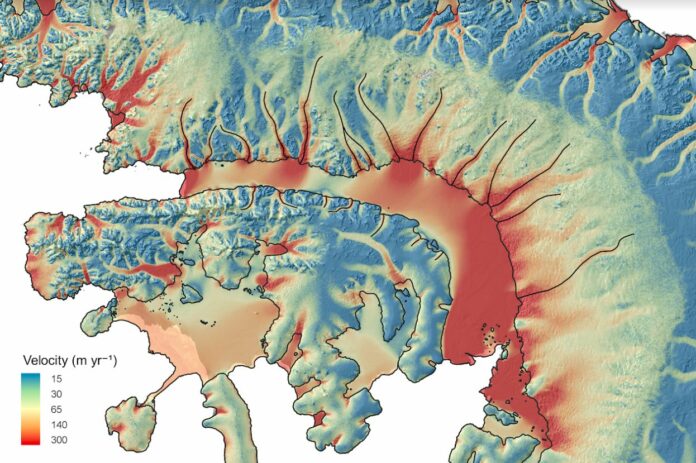Researchers have identified a previously undiscovered source of ice loss fluctuation, suggesting that some estimates of Antarctica’s total contribution to sea-level rise may be over- or underestimated.
Researchers from the University of Cambridge and the Austrian engineering company ENVEO found that the flow of land-based ice that drains into the George VI Ice Shelf, a floating ice platform about the size of Wales, on the Antarctic Peninsula changes in different ways at different times of the year.
Researchers analyzed data from the Copernicus/European Space Agency Sentinel-1 satellite and determined that during the Antarctic summer, glaciers supplying the ice shelf increase their flow rate by about 15%.
Such seasonal cycles in land ice flowing onto Antarctic ice shelves have never been observed before. The findings are published in The Cryosphere.
Although it is common for ice flow in the Arctic and Alpine regions to accelerate in the summer, scientists had previously believed that ice in Antarctica was not subject to similar seasonal changes, especially where it flows into significant ice shelves and where temperatures are below freezing for the majority of the year.
This presumption was fueled in part by the fact that historically there has been a dearth of data gathered from satellites passing over the frozen continent.
As the study’s first author, Karla Boxall from Cambridge’s Scott Polar Research Institute (SPRI) acknowledged, “Unlike the Greenland Ice Sheet, where a high quantity of data has allowed us to understand how the ice moves from season to season and year to year, we haven’t had comparable data coverage to look for such changes over Antarctica until recently.”
According to co-author Dr. Frazer Christie of SPRI, “Observations of ice-speed change in the Antarctic Peninsula have typically been measured over successive years, so we’ve been missing a lot of the finer detail about how flow varies from month to month throughout the year.”
Before the Sentinel-1 satellites, scientists who wanted to study short-term changes in the flow of ice across the whole Antarctic had to use data from optical satellites like NASA’s Landsat 8 to figure out what was going on.
According to co-author Dr. Thomas Nagler, CEO of ENVEO, optical measurements can only be used to study the Earth’s surface during the summer months when there are no clouds. But because these satellites can monitor year-round and in all weather circumstances, they were able to find seasonal ice-flow variation by using Sentinel-1 radar footage.
The reasons behind this seasonal variation are yet unknown. It could be because surface meltwater gets to the bottom of the ice and acts as a lubricant, as happens in the Arctic and the Alps, or it could be because warm ocean water melts the ice from below, making the floating ice thinner and letting glaciers moving upstream move faster.
These cyclical cycles may result from either process alone or from a combination of the two, according to Christie. In-depth observations of the ocean and its surface will be necessary to completely comprehend this seasonal variation.
The findings suggest that other, more vulnerable places in Antarctica, like the Pine Island and Thwaites glaciers in West Antarctica, may experience a similar seasonal variability.
If accurate, these seasonal patterns may go unnoticed in some measures of Antarctic ice mass loss, which might have significant repercussions for projections of the global sea level rise, according to Boxall.
According to co-author Professor Ian Willis, “It’s the first time this seasonal signal has been found on the Antarctic Ice Sheet, so the questions it raises regarding the possible presence and causes of seasonality elsewhere in Antarctica are really interesting.
“We look forward to taking a closer look at, and shedding light on, these important questions.”
Source:10.5194/tc-16-3907-2022
Image Credit: Copernicus/European Space Agency/Karla Boxall
You were reading: Detected An Unknown Source Of Ice-speed Change In Antarctic
